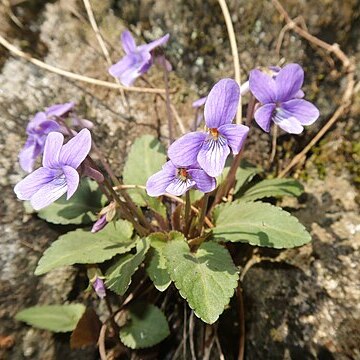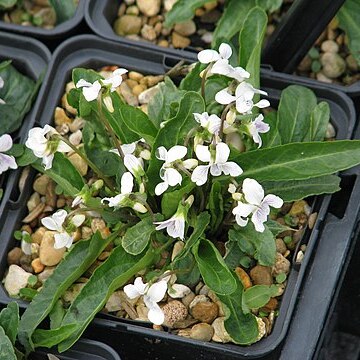Herbs perennial, acaulescent, rosette-forming. Rhizome short, 5-7 mm, robust, ca. 5 mm in diam., densely noded; roots numerous, whitish, elongated, robust. Leaves numerous, basal; stipules narrowly ovate, 2-3 cm × 3-4 mm, ca. 2/3 adnate to petioles, margin remotely ciliate, apex acuminate; petiole usually subequaling blade at anthesis, conspicuously exceeding blade at fruiting, very narrowly winged in uppermost part, usually glabrous; leaf blade ovate, broadly ovate, or triangular-ovate, 3-8 × 3-5.5 cm, both surfaces sparsely puberulous or rarely glabrescent, base deeply or broadly cordate, margin densely crenate, apex acute or slightly obtuse. Flowers light purplish or whitish violet; pedicels not exceeding leaves, puberulous or glabrous, 2-bracteolate near middle; bracteoles linear-lanceolate, ca. 8 mm. Sepals broadly lanceolate, 5-7 × ca. 2 mm, apex acuminate, basal auricles 2-3 mm, apex truncate or 2-denticulate. Upper petals oblong-obovate, 1.3-1.5 cm × 5-6 mm, lateral ones oblong-obovate, 1.1-1.3 cm × 5-6 mm, sparsely bearded or glabrous, anterior one narrowly obovate, 1.7-2 cm (spur included), apex emarginate; spur cylindric, 6-8 mm, 2.5-3.4 mm in diam.; spur of anterior 2 stamens long, 2-3 mm, slender. Ovary conic, glabrous; styles clavate, base slightly geniculate, thickened in upper part; stigmas flat at top, conspicuously margined on lateral sides and abaxially, shortly beaked in front, with a broad stigma hole at tip of beak. Capsule ellipsoid, ca. 1 cm. Fl. Mar and Oct, fr. May-Oct.
More
Plants perennial, acaulescent, not stoloniferous, 3–10 cm; rhizome thick, fleshy. Leaves basal, ca. 5, ascending to erect; stipules ± oblong, 2-fid, proximal margins entire, distal ± serrate, apex acuminate; petiole narrowly winged distally, 1–14 cm, usually glabrous; blade unlobed, broadly ovate or triangular-ovate, 3–8 × 3–5.5 cm, base cordate, margins crenate, usually eciliate, apex acute or ± obtuse, surfaces sparsely puberulent. Peduncles 3–6 cm, glabrous or pubescent, bracteoles near middle. Flowers: sepals broadly lanceolate, margins eciliate, auricles 6–8 mm; petals light violet or whitish violet on both surfaces, lowest 3 occasionally white basally, often dark violet-veined, lateral 2 sparsely bearded or beardless, lowest 17–20 mm, spur pale to dark violet, elongated, 5–10 mm; style head beardless; cleistogamous flowers present. Capsules ellipsoid, 8–10 mm, glabrous. Seeds unknown. 2n = 48.Flowering Apr–Jun. Gardens and ruderal areas; 10–50 m; introduced; Mass.; Asia (China, Japan, Korea).
A herb. It keeps growing from year to year. It does not have a stem but forms a ring. It has a short rhizome. There are many leaves at the base. They are triangle shaped or oval and 3-8 cm long by 4-5 cm wide.
Can be grown by divisions or seedlings. Seeds needs stratification.


